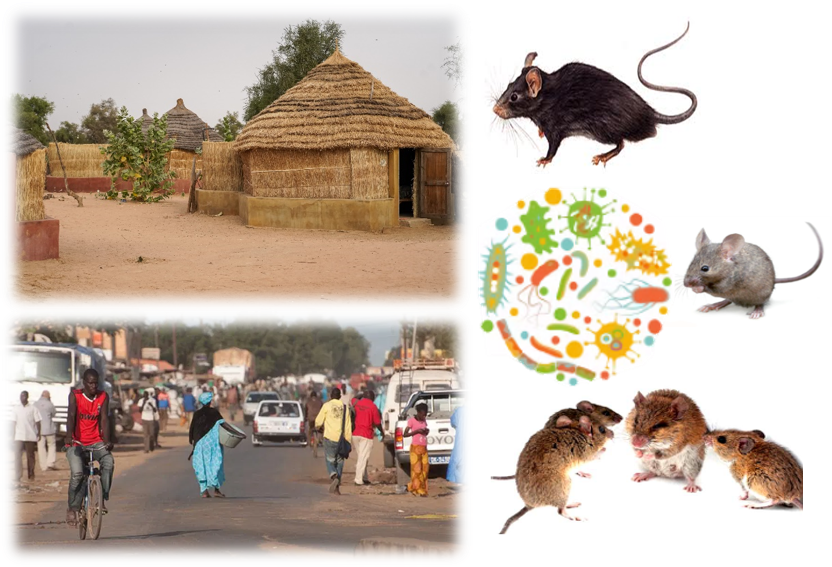Invasion biologique de la souris domestique (Mus musculus domesticus) dans le Ferlo oriental : dynamique d’expansion, interactions rongeurs-parasites et risques sanitaires associés
Biological invasion of the house mouse (Mus musculus domesticus) in the eastern Ferlo: ongoing expansion, rodent-parasite interactions and associated health risks
2022
OHM Project
Tessekere OHMi

Leader : Diagne Christophe
Project leader’s laboratory : Centre de Biologie pour la Gestion des Populations (CBGP)
Full address of laboratory : Centre de Biologie pour la Gestion des Populations (CBGP) 755 avenue du campus Agropolis 34988 Montferrier sur Lez Cedex
Coauthor(s) : Laurent Granjon
Keywords :
invasions biologiques
rongeurs commensaux
helminthes
bactéries
Ferlo oriental
Disciplines :
Biologie
Eco-epidemiologie
Ecologie
Ecologie de la sante
Abstract :
La souris domestique (Mus musculus domesticus) est une espèce commensale invasive dont la progression au Nord Sénégal a connu une accélération ces dernières années, notamment du fait du développement des infrastructures routières et de l'augmentation du trafic routier et du transport de biens et personnes. C’est sur la base des changements écologiques et sanitaires liés à la progression fulgurante de ce rongeur commensal (mis en évidence dans nos projets précédents) au Ferlo Central que nous proposons, dans ce projet, d’étendre nos travaux au Ferlo oriental. Dans cette région traversée également par le tracé de la Grande Muraille Verte, nous ambitionnons d’inventorier les petits mammifères présents dans les habitations et de caractériser les communautés de parasites (helminthes gastro-intestinaux) et pathogènes (bactéries potentiellement zoonotiques) en circulation dans ces communautés. Une comparaison avec les données du même type acquises ces dernières années dans les habitats typiques du Ferlo central permettra de mettre en avant les patrons généraux et spécifiques associés à l’expansion géographique en cours de la souris domestique. Parallèlement, la caractérisation de traits liés à la fonction immunitaire des rongeurs pourra être analysée et mise en relation avec d’éventuels contrastes en termes de risques d’infection entre les sites/zones étudiés. Par ses actions complémentaires avec des projets connexes dans le cadre de l’OHMI Tessekere, ce travail permettra l’investigation concertée des facteurs déterminants et des conséquences (biodiversité, santé publique) de l’expansion en cours de la souris domestique dans cette zone.
Translated abstract :
The house mouse (Mus musculus domesticus) is one of the major invasive alien rodent worldwide, which currently invades Northern Senegal thanks to the development of road infrastructure and the ever-increasing increase road traffic and human exchanges. Our previous works in Central Ferlo evideenced significant ecological changes and potential health issues associate with the ongoing spread of this commensal rodent. Here, we target the eastern part of the Ferlo region (also crossed by the Great Green Wall initiative) where we aim at investigating the commensal (native and invasive) rodent communities small mammals and their parasite (gastrointestinal helminths) / pathogen (pathogenic bacteria) assemblages. The data gathered in this project will be compared to those obtained in our previous studies in the central part of the Ferlo region. Such comparative approach will allow to highlight the general and specific patterns associated with the ongoing expansion of the house mouse in Northern Senegal. Concomitantly, we will decipher the immune profile of the analyzed rodents, and try to analyse potential relations between immune reactions, environment and infection patterns within rodent populations. Our project is closely linked to other ongoing projects supported by the OHMi Tessekere, and will provide a strong basis for further concerted and interdisciplinary approaches aiming to understand the underlying factors and (biodiversity, public health) consequences of the ongoing spread of the house mouse in this area.

